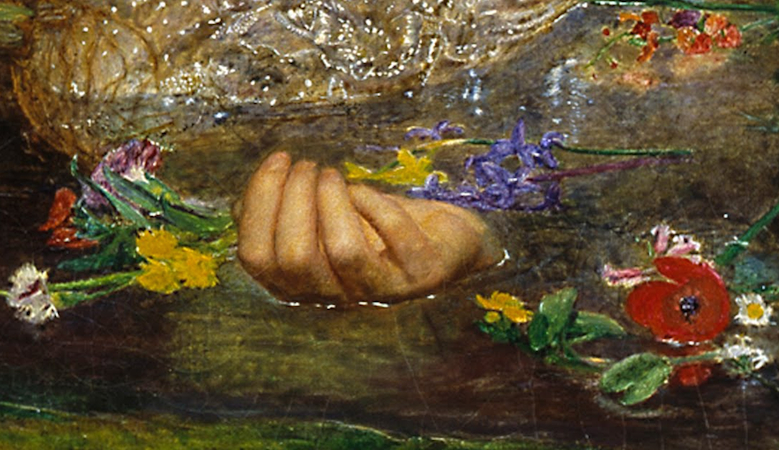Ophelia's Iris - Rose of May
- ARTPENDIX ARTICLE

- May 30, 2023
- 3 min read
Updated: Jun 4, 2023

Sir John Everett Millais (8 June 1829 – 13 August 1896) was an English painter and illustrator, founder of the Pre-Raphaelite Brotherhood. In Millais's time, it was common for artists to sketch outdoors, often bringing sketches back to studios as a reference to gigantic paintings. But Millais and his Pre-Raphaelite companions often painted directly outdoors in the open air, which remains exceptional today.
Landscapes are frequently seen as background in classic paintings - but the Pre-Raphaelites thought that landscapes were equally significant as humans; hence landscapes were finished before the figures.
In Hamlet by William Shakespeare, Ophelia appears as a character. She was afflicted by sadness and lunacy after finding out that her father, Polonius, was killed by her beloved, Hamlet, and she spends the entire day wandering around and singing weird songs before tragically drowning in the water.
Millais had a potent and enduring image by fusing his interest in Shakespearean subjects with a keen eye for the details of the natural world. It was approvingly distinctive at the time because he chose a scene from the play Hamlet where Ophelia drowns in mental disorder following her father's death - it gave Millais a prospect to demonstrate both his technical prowess and imaginative vision.

Ophelia's body floats in the water, her torso starting to sink. Viewers can sense the weight of the cloth dragging her down. Her hands are in a surrendering position as she accepts her destiny.

Shaded by an array of flora and summer blossoms where specifically Shakespeare's text mentioned, others got used for symbolic purposes. The purple on Ophelia's neck symbolises faithfulness, chastity and death.
The tragedy of "Ophelia" is retold in Millais' art by natural vegetation features, identical to what Shakespeare did with words to show the world Ophelia's death.
The scene when Ophelia crafts a wreath and plunges into the water as she prepares to dangle a branch is the one chosen by Millais.
Sang as she slowly sank to the bottom of the river after falling in while collecting flowers. Her attire stretched out, causing her to float on the water like a mermaid. She also sporadically sang old ballads acting as if she did not sense the peril or that she had grown in the water.
(Scene 11 of Hamlet)

"Ophelia" features flowers and other flora that either symbolic or mentioned in the play. The artwork includes flowers from many seasons since Millais spent five months painting on the riverside after discovering wildflowers near the river in Hogmil.
The weeping willow leaning on Ophelia implies abandoned love.
Buttercups in the foreground represent ungratefulness or foolishness.
Nettles that grow on the branches of the willow tree denote pain.
Ophelia's right side's floating flower is a symbol of innocence. Act IV, Scene 5 has the remark "There is a daisy" from Ophelia.
Pink roses floating on Ophelia's cheeks and skirts and the white field roses growing on the riverbank may refer to Leotis calling his sister 'The Rose of May' - conveys youth, love, and beauty.
Violet wreath around Ophelia's neck is from Act IV, Scene 5. Violets emit about loyalty but also of moriality and death.
Purple Loosestrifes and Spiraea could mean that Ophelia's death is futile.
Ophelia is the only female tragedy in any of Shakespeare's works. In such a society, women had spare status, were not allowed to communicate their minds, had nowhere to express their emotions, and could only act invisibly as mechanisms to uphold male supremacy.
We have been seeing Hamlet's love and hate and watching his indecision, but we rarely see the description of Ophelia's inner world. Shakespeare might want to show the tragedy of countless women of the old era represented by Ophelia, but his writing perspective is still mannish.
Unquestionably, Millais's paintings are breathtakingly beautiful. He rebuilds Ophelia's death with a silence triggered by lush grass and vibrant flowers. Ophelia's eyes were slightly open to be praying for something with the movement of holding her hands, but her expression lives peacefully.
Perhaps Millais was sympathetic to Ophelia and gave her a fantastic death without pain - But we all know drowning is painful.
Litterateurs, in another sense, are artists. They can relate to content on an emotional level and create a new piece in their own "language". To be sure, good writers will create images and weave colors like artists, and artists will likewise be as imaginative and emotional as literary artists.
Shakespeare and Millais came to a spiritual understanding to give Ophelia, the unfortunate woman, a joyful ending. Ophelia was set free, no longer subject to the dominance of men - she shed the "madness" label, passed away gently and softly while holding her wreath, and did it with dignity and grace on a rainbow day.
Zülal Erk
7:23 PM
Tuesday, May 30, 2023
İstanbul, Türkiye
Artpendix Press




Comments